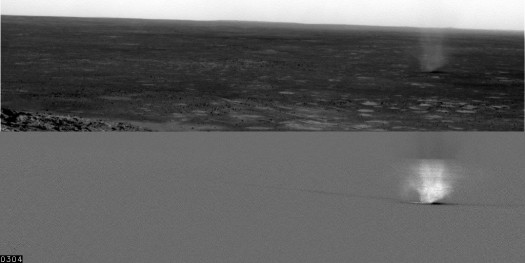Martian Devils
December 2006By by Dr. Tony Phillips
by Dr. Tony Phillips;>> Macro menumgr_macro_spaceplaceimage not found <<
Well, you can imagine the thrill in 2004 when scientists were checking some of those pictures and they did see something leap out. It skittered across the rocky floor of Gusev Crater and quickly disappeared. But it wasn’t a Martian; Spirit had photographed a dust devil!Dust devils are tornadoes of dust. On a planet like Mars which is literally covered with dust, and where it never rains, dust devils are an important form of weather. Some Martian dust devils grow almost as tall as Mt. Everest, and researchers suspect they’re crackling with static electricity—a form of “Martian lightning.”
NASA is keen to learn more. How strong are the winds? Do dust devils carry a charge? When does “devil season” begin—and end? Astronauts are going to want to know the answers before they set foot on the red planet.
The problem is, these dusty twisters can be devilishly difficult to catch. Most images of Martian dust devils have been taken by accident, while the rovers were looking for other things. This catch-as-catch-can approach limits what researchers can learn.
No more! The two rovers have just gotten a boost of artificial intelligence to help them recognize and photograph dust devils. It comes in the form of new software, uploaded in July and activated in September 2006.
“This software is based on techniques developed and tested as part of the NASA New Millennium Program’s Space Technology 6 project. Testing was done in Earth orbit onboard the EO-1 (Earth Observing-1) satellite,” says Steve Chien, supervisor of JPL’s Artificial Intelligence Group. Scientists using EO-1 data were especially interested in dynamic events such as volcanoes erupting or sea ice breaking apart. So Chien and colleagues programmed the satellite to notice change. It worked beautifully: “We measured a 100-fold increase in science results for transient events.”
Now that the techniques have been tested in Earth orbit, they are ready to help Spirit and Opportunity catch dust devils—or anything else that moves—on Mars.
“If we saw Martians, that would be great,” laughs Chien. Even scientists have their guilty pleasures.
Find out more about the Space Technology 6 “Autonomous Sciencecraft” technology experiment at nmp.nasa.gov/st6/TECHNOLOGY/sciencecraft_tech.html, and the use of the technology on the Mars Rovers at nmp.nasa.gov/TECHNOLOGY/infusion.html. Kids can visit spaceplace.nasa.gov/en/kids/nmp_action.shtml and do a New Millennium Program-like test at home to see if a familiar material would work well in space.

The top half of this image is part of a series of images of a passing dust devil on Mars caught by Spirit. In the bottom half, the image has been filtered to remove everything that did not change from one image to the other. Notice the faint track left by the dust devil. Credit NASA/JPL/Mark T. Lemmon, Univ. of Arizona Lunar and Planetary Laboratory.
This article was provided by the Jet Propulsion Laboratory, California Institute of Technology, under a contract with the National Aeronautics and Space Administration.



